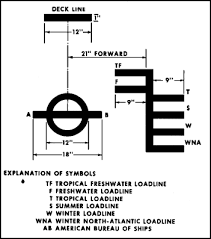I decided to join in on the Daily Posts challenge: Symbol. I thought about the waterline one immediately. I think if you haven’t spent a lot of time around ships, you might not know what this one means, even if you see it around you all the time.
This symbol for the ships waterline is called the Plimsoll line, after Samuel Plimsoll. It’s also called the international load line since its function is to inform as to the maximum level a ship can be loaded safely. To put it simply, if it’s underwater, the ship is overloaded and therefore unsafe to sail!
If you look at a ship, you should see this symbol midships (about halfway between the bow and stern). All commercial ships should have this prominently marked on their hull. The ‘deck line’ marks where the main deck level is located. The ‘A’ and ‘B’ on either side of the circle refers to the ‘class society’. In this case the American Bureau of Shipping. It could say LR (Lloyds Register) or BV (Bureau Veritas) or otherwise classed. These are the people who actually figure out exactly where the marks should be placed.
The markings to the right of the circle refer to the type (fresh, brackish or salt) and temperature of the water the ship is floating in. The density of the water changes according to these variables and so the ship will float higher or lower in the water when she sails in different conditions. And so the ship can be loaded with more or less cargo.
The Plimsoll line has saved thousands of lives since Mr Plimsoll first started working to stop overloaded vessels from heading to sea (with subsequent losses of ships and sailors). Plimsoll fought hard to stop the ‘coffin ships’ from sailing and spent years trying to enact legislation to protect the people who worked at sea. Here’s a bit from A Cheer For Plimsoll written and sung by Fred Albert in 1876
So a cheer for Samuel Plimsoll and let your voices blend
In praise of one who surely has proved the sailors’ friend
Our tars upon the ocean he struggles to defend
Success to Samuel Plimsoll for he’s the sailors’ friend.
There was a time when greed and crime did cruelly prevail
and rotten ships were sent on trips to founder in the gale
When worthless cargoes well-insured would to the bottom go.
And sailors’ lives were sacrificed that men might wealthy grow.
For many a boat that scarce could float was sent to dar the wave
’til Plimsoll wrote his book of notes our seamen’s lives to save
His enemies then tried to prove that pictures false he drew
but with English pluck to his task he stuck, a task he deemed so true.
It wasn’t until the loss of the SS London in 1866, with the loss of over 200 lives, that Parliament started paying attention to Plimsolls’ simple solution. In 1876, the UK made the load line marking mandatory, but it took until 1930 for any international agreement to come about.
The Plimsoll line has made shipping much safer, at least for the ships that follow its direction. It’s a simple enough thing that anyone can take a look and see if the ship is overloaded or safe to sail. But it looks to me like greed (on the part of shippers) and fear for their jobs (on the part of the mariners) keeps overloaded and unsafe ships sailing the worlds oceans. I think from plenty of news items, (like this, this, and this, etc), that people around the world are still not taking advantage of this hard earned knowledge.





great post!!!…the voice(translation?) sux though
glad you liked it. Sorry about the voice.
it’s cool…sure it was a translation thingy and I don’t speak any other language
Pingback: Weekly Photo Challenge: Symbol – Maria Jansson Photography
thanks for sharing my post.
Pingback: 15-07-13 Weekly Photo Challenge – Symbol (Of The Past) | The Quotidian Hudson
Thanks for teaching me something new. As a writer, I’m sure this will crop up in some future narrative. Calm seas to you.
Thanks, I’m glad you found it interesting.